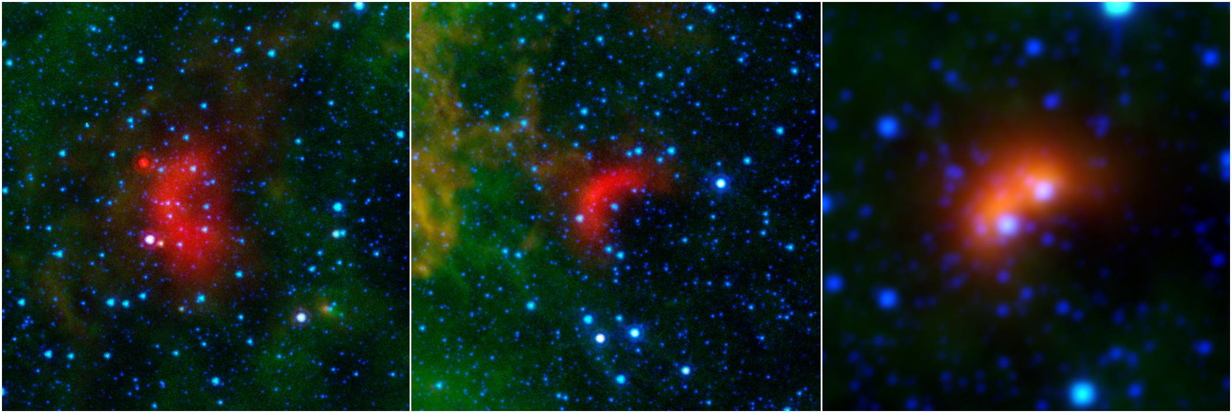High-Speed Stars Make Telltale Waves

KISSIMMEE, Fla. — The galaxy's fastest stars may have just become easier to pick out of a crowd.
As they race away from their stellar siblings, some speedy stars push material in front of them to create a visually striking, half-circle formation that a group of astronomers has used to identify a large number of fast-moving candidates.
"Over the past year, we have identified hundreds of hot, massive star candidates streaming at supersonic speeds," William Chick said last week at a press conference at the 227th annual meeting of the American Astronomical Society in Kissimmee. [Top 10 Star Mysteries]
Chick, a graduate student at the University of Wyoming, is part of a team of astronomers that pored through archived images taken by NASA's Wide-field Infrared Survey Explorer (WISE) and Spitzer Space Telescopes in search of the wavelike structures, then identified fast-moving stars as their source.
"Using Spitzer and WISE, we have identified hundreds of hot dust structures with arclike shapes, revealing a previously uncategorized group of objects," Chick said.
Speeding stars
Most stars move on a fairly predictable path through the galaxy, moving away from the region where they were born slowly and without fanfare. But hypervelocity stars travel at a much faster clip. Zeta Ophiuchi, a bright star in the constellation of Ophiuchus, moves at around 67,000 mph (30 kilometers per second) compared to background material. By comparison, the sun travels at only about 43,000 mph (19 km/s). If they travel fast enough, such stars can even leave the Milky Way galaxy.
Finding a fast-moving star in the galaxy may initially be a task much like finding the proverbial needle in a haystack. But as Zeta Ophiuchi and stars like it zoom through the slower surrounding dust and gas, they push the matter in front of it, creating a striking bow shock in the cooler material.
Get the Space.com Newsletter
Breaking space news, the latest updates on rocket launches, skywatching events and more!
"It's similar to jets moving at supersonic speeds, causing the material to pile up in front of them," Chick said.
Chick and his colleagues identified more than 200 fuzzy features captured in infrared light by Spitzer and WISE. They then used the Wyoming Infrared Observatory to follow up on 80 of the objects, examining the arc-shaped features in search of stars that could create them. Although they anticipated these stars would influence the formation of some of the arcs, they were startled to see just how prominent a role they played.
"We were surprised that over 95 percent of them were, in fact, hot, massive stars, as we predicted," he said.
"It appears that bow-shock nebulae are an extremely efficient method of locating these hot, massive runaway stars."
An energetic kick
Zeta Ophiuchi is a young star, five times hotter and 20 times more massive than the sun. Like the sun, it likely formed in a cluster with other young stars. But something happened to kick Zeta Ophiuchi from its original path.
"To get something the size of these stars up to these speeds, there needs to be a pretty energetic event to get them moving," Chick said.
Although scientists aren't completely certain of what provided the energy boost, two methods rise to the top of the list. As a star travels through space, it may pass a massive object such as a black hole. Gravity kicks in, slingshotting the star into space at accelerated speeds. Alternatively, two stars in a binary system may age together, until one dies young in a violent supernova. The explosion may have enough energy to propel the survivor outward at supersonic speeds.
Chick and his team can't rewind time to see the events that booted their bow-shock-forming stars, but they can trace the star back through space to find its birthplace and try to determine what sent it packing. For instance, if the speedy star was kicked out by a companion supernova, the remnant should be visible when the astronomers backtrack.
According to Chick, it's very likely that both mechanisms play a role in ejecting these stars. He said that the team has already identified several likely cases for both scenarios, though additional observations are needed for any individual case.
"It may be that our Milky Way is swarming with these hot, runaway stars," he said.
Follow Nola Taylor Redd on Twitter @NolaTRedd or Google+. Follow us @Spacedotcom, Facebook or Google+. Originally published on Space.com.
Join our Space Forums to keep talking space on the latest missions, night sky and more! And if you have a news tip, correction or comment, let us know at: community@space.com.

Nola Taylor Tillman is a contributing writer for Space.com. She loves all things space and astronomy-related, and enjoys the opportunity to learn more. She has a Bachelor’s degree in English and Astrophysics from Agnes Scott college and served as an intern at Sky & Telescope magazine. In her free time, she homeschools her four children. Follow her on Twitter at @NolaTRedd









